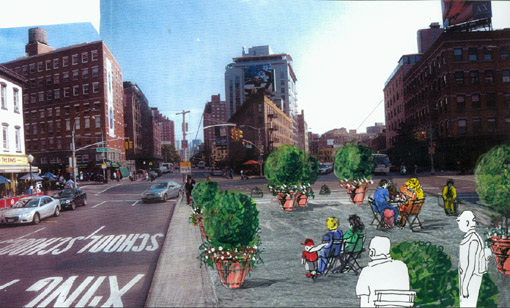BY HEATHER DUBIN | The smell of meat hits you at the door. Once an omnipresent odor in the Meatpacking District, it can still be found here, at the “Co-op,” the last remnant of a bustling meat market that was once much, much larger.
The address is 832 Washington St., home to JT Jobbagy, a meat wholesaler, and six other meat companies.
Tucked under the High Line and next door to Hector’s, an old-school diner on the corner of Little West 12th St., the Co-op represents a slice of New York that is long gone. Today, there is a Disneyland feel to the Meatpacking District with designer clothing shops, high-end restaurants and nightclubs, in sharp contrast to the raw market neighborhood it was.
Brothers John and Tom Jobbagy started JT Jobbagy together in 1990, having followed in their father’s footsteps, who also worked in the industry. The male-dominated world that was the old Meat Market covered a six- or seven-block area — with three major buildings on the current Co-op block — and employed a couple thousand men. These days, the remaining handful of meat businesses are clustered in one last building. The massive new Downtown Whitney Museum, currently under construction, replaced the other old meat buildings on this same block.
John Jobbagy, who begins his day at 4:30 a.m., recently took some time out of his afternoon to talk about the meat industry and how it has changed. His older brother Tom sat next to him, busy fielding customers’ calls and doing paperwork.
“We’ve been here in this building when it was completely a market,” John said. “It was all just meat, tons of vendors, a few of the bigger companies and wholesalers.”
Carcasses were trucked in, cut up and sold to supermarkets and other meat companies.
Now the Jobbagys have 14 employees, and the rest of the meat businesses left on the block are similar in size. They still do carcasses — fresh hanging like they did years ago — wholesale restaurants, retail markets and also supply other meat companies. But today, the bulk of their work is supplying restaurants.
While Jobbagy recalled the Meat Market as a former place of fast action with trucks roaring in and out and camaraderie, he is more pragmatic than nostalgic. With the industry changes and surrounding newly posh neighborhood, he acknowledged things could never be the same.
“Back in the day, it was an all-male world,” he said. “There were four to five women as bookkeepers — it wasn’t a universe without women — but it was without women in the meat lockers.”
Jobbagy described the men as a bunch of blue-collar guys who cursed a lot and worked in extreme temperatures year-round.
“Everyone knew each other. It was a community and it was an interesting sort of meat world,” he said. “Any group of 2,000 blue-collar workers who knew each other — it was a cast of characters.” These same men may have also frequented the nearby Frank’s Restaurant or a local diner that is now Hogs & Heifers bar, or strip clubs and the three or four topless clubs that used to exist in the vicinity.
According to Jobbagy, when Pastis, Keith McNally’s French bistro, opened up at Ninth Ave. and Little West 12th St. in 1999, everything changed. The area rapidly became fashionable, more restaurants popped up, and “Sex and the City” filmed there along with “Law & Order” and movies.
“It’s really noticeable in this area — without a doubt, the transformation is really vivid,” Jobbagy said.
As for the meat industry, older buildings, mostly from the 1900s, were no longer able to meet United States Department of Agriculture codes. Wooden beams in buildings had rotted from the moisture over the years and needed to be replaced. Also, the U.S.D.A. grew stricter concerning drains, walls and floors.
Additionally, beef and pork were now not only being produced, but also carved and packed, in the Midwest.
“They had slaughterhouses back in the Midwest, and then got smart and built packing plants,” Jobbagy said. And finally, the meatpacking owners were in their 60s, and Jobbagy noted, there was “no more succession.”
These factors and economics prompted the meat industry to go elsewhere, with many relocating to newer, modern facilities in Hunts Point in the Bronx or New Jersey.
But the brothers are not going anywhere, and they are successfully doing what other meat companies do, though on a smaller scale.
“Beef is our biggest thing,” Jobbagy said. “We also do veal, lamb, pork and poultry — we do all the species.”
When asked if he was headed out for a vegetarian lunch at the close of the interview, Jobbagy laughed and exclaimed, “No, I’m going to Hector’s to have a Jobbagy burger!”


















